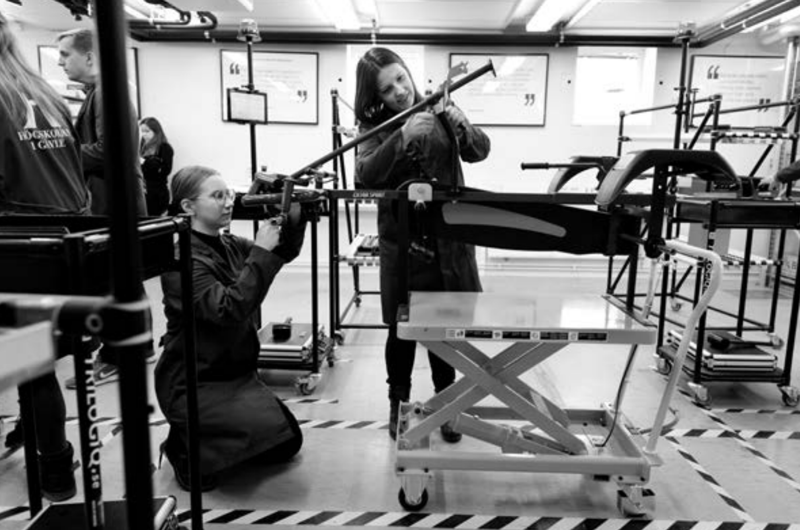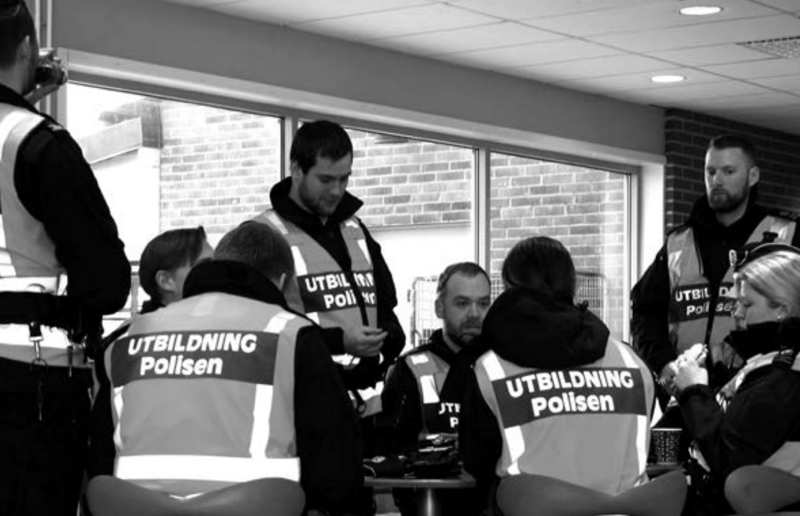Step 1: Prerequisites for gender mainstreaming
Experience has shown that there are some important prerequisites for work with gender mainstreaming which will lead to results and effects. In this part, prerequisites are described in the form of a clear management and control of the work, an expedient organisation where the work can be carried out in the core functions, and that there is support for and coordination of the work.

1.1 Management and governance
Perhaps the most important prerequisite for successful work with gender mainstreaming is that the work is well anchored in governance and management. Similar to other change and improvement work, it is the management that has the overall responsibility. It is responsible for clarifying the direction, goals and division of responsibilities in the work. Top management as well as managers at all levels also need to follow up the work continuously and demand results.
Managers at all levels in the organisation need to create the conditions for implementation.
Management needs to clarify what gender mainstreaming means for each actor in the power chain. Through clear communication that creates an understanding of the assignment and what is expected of each actor, the conditions for the work to be prioritised and carried out increase. It is also an advantage if there is a designated manager in top management who carries and monitors the issues.
In order for gender equality work to have an impact throughout the organisation, managers at all levels need to take responsibility for, be driving and participate actively in the work where they have managerial responsibility. Managers at all levels in the organisation need to create conditions for implementation by creating an organisation for the work, allocating resources and ensuring knowledge and process support.
The need for a clear direction, concrete goals and anchoring in the organisation is particularly important in larger authorities and educational institutions with a decentralised or geographically dispersed operation. It is also important that gender mainstreaming is related to and becomes part of the various forms of governance of authorities and higher education institutions, for higher education institutions, for example, both line management and collegial management.
The University of Gävle identified a lack of systematicity in the gender equality work and that it was not integrated into the operational planning process. In 2017, it was decided that all managers must attend a mandatory and credit-bearing training in Gender and organisation (4 credits).
The starting point was that managers' knowledge and awareness of gender and equality is a basic prerequisite for developing measures to create an equal organisation. Within the framework of education, various inequality problems have been identified, including gender-segregated study choices, that student health does not reach men as well as women to the same extent and that career paths are not transparent.
The training achieved good results, in the form of increased awareness and knowledge. The heads of the educational institution own and run the work to integrate gender equality at their respective academies and are responsible for driving the development work for increased gender equality. Read more in our report Jämställdhet i akademin (Gender equality in academia) (2020).

1.2 Gender equality work as part of the core function
In order for the work with gender mainstreaming to lead to results and effects, it needs to take place in relation to and as part of the organisation's main function and core processes. If, on the other hand, gender equality work is placed alongside central or strategic processes or assignments, the organisation risks spending time and resources on work that does not have an impact.
Previous experience from the government's development program for gender mainstreaming in authorities shows that authorities who feel that the work with gender mainstreaming promotes their core function, instead of being in competition with or at the expense of, have had a greater impact in the work. The desire to prioritise and devote resources to the work is greater if employees and management see the benefit of the work.
The Swedish Civil Contingencies Agency (MSB) is tasked with developing society's ability to prevent and manage accidents and crises. In 2017, the agency reviewed the work with gender mainstreaming, and developed a new strategy with the aim of tying the work closer to the core missions and making visible the inequality problems that the agency's work with gender mainstreaming must solve.
The strategy is based on a problem description based on the agency's instructions and regulation letter in relation to the gender equality policy goals. The approach is reviewed by the agency to have been decisive for the work with gender mainstreaming in that it created an understanding of why the work should be carried out and has integrated it into the agency's regular work.
Read more in our report Jämställdhethetsintegrering i myndigheter 2019 (Gender equality integration in authorities 2019) or on the website of the The Swedish Civil Contingencies Agency (MSB).

1.3 Internal support and coordination
The management needs to ensure that the necessary resources are allocated for internal coordination. Having a function that coordinates the work has proven to be a success factor.
The coordination function needs to have a clear mandate to coordinate the issues without taking over the responsibility for equality work from management. If the coordinator is strategically placed in the organisation, has access to the management team and has a mandate linked to operational issues, the opportunity to contribute to development increases.
For those who have a decentralised or geographically dispersed operation, it may be relevant to have internal support at several levels in the organisation. Creating internal networks with local co-ordinators for gender equality or other strategic functions within different parts can be a way of organising the support.
1.4 External support and collaboration
In the work with gender mainstreaming, external support may be needed, for example, in the form of training, coordination, process support and tools for the practical work. The support needs to be concrete, adapted to the organisation, based on the needs it has and from an understanding that different organisations have different prerequisites.
The Swedish Gender Equality Agency has a permanent mission to provide support to state authorities in their work with gender mainstreaming. There is also good experience from both authorities and higher education institutions in cooperating with other authorities or higher education institutions in the same sector or with similar assignments in order to share experiences, lessons learned and working methods as well as cooperate around common challenges.
The county boards are the government's regional structure for the implementation of gender equality policy in Sweden. All county administrative boards are tasked with supporting the activities of authorities with gender mainstreaming at the regional and local level.
1.5 Gender mainstreaming in relation to related goals and assignments
The collective gender equality work is based on assignments and requirements such as instructions, government assignments, laws and regulations. In order to contribute to more efficient management and implementation of the work with gender mainstreaming, the organisation can advantageously clarify what the various assignments and requirements in the gender equality area look like, how they can be organised in relation to each other and what synergies exist between them. At the same time, it is also important to look at delimitations, when it does not work and why.
By working with more systems of power in gender equality work, based on a so-called intersectional approach, better results can be achieved.
For example, in Sweden, the work with gender mainstreaming is connected to the Discrimination Act's requirement for active measures to prevent discrimination and work for equal rights and opportunities. Gender is one of the grounds for discrimination covered by the legislation and active measures must be taken in several areas that are also the focus of the work with equality integration. Examples of such areas are work environment, resource allocation and countering sexual harassment.
Different types of discrimination and oppression, such as sexism, racism and homophobia interact and also overlap with each other to a large extent. By working integratedly and cohesively with several other systems of power in gender equality work, based on a so-called intersectional approach, better priorities and greater accuracy in implementation can be achieved.
Another area with clear connections and possible synergies is the work to prevent and combat men's violence against women based on sub-goal 6 and the national strategy.
Gender mainstreaming must contribute to the fulfilment of sub-goal 6, but is often carried out in different tracks, even though it can be advantageously co-organised. Read more about how in the next part of the guide Plan for a gender equal organisation.
The Swedish Enforcement Authority (Kronofogden) has long worked with gender mainstreaming to contribute to the achievement of the gender equality policy goals. Violence in intimate relationships causes great human suffering and costs Swedish society around 43 billion annually. In order to discover and support those who are exposed to violence, authorities can make a big difference. The Enforcement Authority has introduced routines to help those who are exposed to violence in an intimate relationship. In order to strengthen the violence prevention work, the authority has also developed a competence and experience exchange on violence in intimate relationships with a focus on economic violence together with the Swedish Public Employment Agency, the Tax Agency and the Social Insurance Agency.
In addition to tasks related to gender equality, several organisations and public actors also have LGBTQ strategic tasks, tasks to implement goals and measures in Sweden's National Plan against Racism, tasks to work to promote children's rights and more. Making different tasks visible in relation to gender equality work and thinking about possible connections and synergies can strengthen gender equality work and vice versa. The work with sustainable development based on Agenda 2030 is also a current area to connect the work to, where gender equality is one of the social sustainability dimensions and a prerequisite for meeting the goals of the agenda.
Collegial governance
Higher education institutions have many different missions that link to gender mainstreaming in different ways. In the regulatory letter for higher education institutions for the 2022 budget year, it is also expressed that the task of gender mainstreaming can advantageously be coordinated with other tasks.
The most common areas to connect to gender mainstreaming are, apart from the Higher Education Act and the Higher Education Ordinance, the mandate on expanded recruitment, distribution of research funds, the professorial goal, equal conditions work and Agenda 2030.
In order for the steering processes to be effective and strategic, it is good to start by creating an overview of all development areas linked to equality and inequality, and then analyse how they can strategically strengthen each other.
Gender mainstreaming has similarities to, but at the same time differs from, work with active measures. Active measures are preventive and promotional work to counter discrimination within an organisation and otherwise work for equal rights and opportunities regardless of the basis of discrimination.
The work is governed by law and focuses on seven different grounds of discrimination and the individuals and groups of individuals who are in the organisation in question. The work with gender mainstreaming, on the other hand, is goal-directed, and is based on the gender equality policy goals with the aim of contributing to both organisational and societal effects. Much focus is on redistribution of resources and power. The work with gender mainstreaming must generate more long-term action proposals with a focus on business development and social change.
Coordinating the gender mainstreaming work with active measures in the management and operational systems that govern and hold the authorities' work together can contribute to increased impact in terms of gender equality both inside and outside the organisation. By integrating the parts into ordinary operations, the risk of the work ending up on the sidelines or becoming dependent on people is reduced.
The police training at Malmö University includes understanding, analysing and dealing with various forms of sexism, racism and discrimination. Through theoretical knowledge and practical exercises in power analysis, the future police officers gain a broader competence and better conditions for solving crimes. Read more about Malmö University's work to increase awareness of different power systems that affect the professional practice of the police on Malmö University's website or in the Swedish Gender Equality Agency's report Gender Equality in Academia 2019 (Jämställdhet i akademin 2019).

1.6 Competence
Gender equality work requires different types of skills. On an overall level, knowledge is needed about gender equality policy, the gender mainstreaming strategy and knowledge about power and gender. In addition, knowledge is needed about what affects different groups of women and men, girls and boys, within the subject area of the activity.
Different competencies need to be found in different functions. Every business needs to make an assessment of what competence is required to be able to carry out the work, what competence exists and whether the competence is in the right place within the organisation.
Knowledge of gender equality, and how inequality arises and is maintained and can change is essential to be able to carry out change work. In order to be able to accurately identify inequality problems, knowledge is also needed about how other systems of power interact with gender, for example, socio-economic conditions, skin color and age and how they affect people.
That competence for gender equality work is found in strategic functions in the organisation is a prerequisite for conducting successful work, but knowledge alone does not lead to change. Training needs to be linked to a specific change process or concrete development work to have any effect. Based on the knowledge, the work with gender mainstreaming needs to be organised so that an institutional learning is created that remains in and spreads within the organisation.
1.7 Questions for reflection
- In what way does top management show ownership of the work with gender mainstreaming?
- Is there a management function that carries and monitors the work in top management?
- How is clarity created in terms of meaning and responsibility for gender equality work, at all levels in the organisation?
- To what extent is gender equality work carried out as an integrated part of the core functions?
- What is required to integrate it to a greater degree in core operations and ordinary processes?
- Do we have a function that supports and coordinates the work with gender mainstreaming?
- Does the function have a clear mandate and sufficient resources?
- Can cooperation with other authorities or educational institutions be a support in our work? If so, with which ones?
- Can our inequality problems be better solved by different missions and goals related to power and gender being better coordinated and synchronised with each other? How? What do we need to do?
- What equality skills do we have in our organisation?
- What competence exists around how other power systems interact with gender?
- How do we ensure the right competence in key functions, for example, management team, analysis department, organisational development?
- How can knowledge contribute to change, within the relevant part of the organisation? In other parts?
Last updated: 21:34 - 2 December 2024
